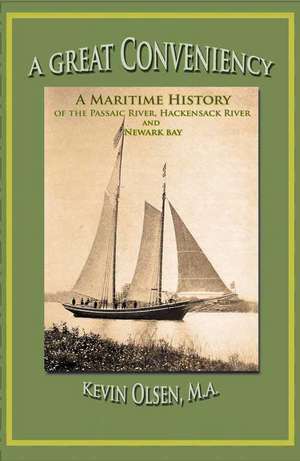A Great Conveniency - A Maritime History of the Passaic River, Hackensack River, and Newark Bay
Autor Kevin Olsenen Limba Engleză Paperback – 31 mar 2008
Preț: 148.11 lei
Nou
Puncte Express: 222
Preț estimativ în valută:
28.37€ • 29.22$ • 23.76£
28.37€ • 29.22$ • 23.76£
Carte tipărită la comandă
Livrare economică 24 februarie-10 martie
Preluare comenzi: 021 569.72.76
Specificații
ISBN-13: 9780975366776
ISBN-10: 0975366777
Pagini: 246
Dimensiuni: 229 x 152 x 15 mm
Greutate: 0.39 kg
Editura: American History Imprints
ISBN-10: 0975366777
Pagini: 246
Dimensiuni: 229 x 152 x 15 mm
Greutate: 0.39 kg
Editura: American History Imprints
Notă biografică
Kevin Olsen is a member of Montclair State Universitys Passaic River Institute. He is a native of northern New Jersey and at one time or another has paddled up, floated down, or sailed over every important water body in the region. He is a former officer of the North Jersey Highlands Historical Society. He has been a volunteer at Wayne Townships Van Riper Hopper House Museums Archaeological Research Laboratory and a docent at the Dey Mansion Museum. During a brief time as a professional field archaeologist he worked on sites in the Delaware Water Gap, lower Manhattan, and at the Monksville Reservoir in Ringwood, New Jersey.He has a B.S. in chemistry from New Hampshires Plymouth State University and a M.S. in chemistry from New Jerseys Montclair State University. He is currently employed as an instrumentation specialist on the support staff of Montclair States Chemistry and Biochemistry Department.His past publications on local history have appeared in the North Jersey Highlander, the American Neptune, and the Encyclopedia of New Jersey.His papers about the history of chemistry have appeared in the Bulletin for the History of Chemistry and the Indicator, News Magazine of the North Jersey Section of the American Chemical Society.
Descriere
"A Great Conveniency, a Maritime History of the Passaic River, Hackensack River, and Newark Bay" describes the role that riverine and coastal navigation played during the development of northern New Jersey. Commencing in the early 1600s with the European exploration of the local waterways, it relates how rivers facilitated early settlement and expanded the highway network into the hinterlands. Landings developed at Acquackanonck (Passaic), Bound Creek, New Bridge (New Milford), and Old Bridge (Oradell), and the towns of Belleville, Hackensack, Little Ferry, and Paterson depended on river traffic for commerce. River proximity allowed British forces to raid the area during the American Revolution, and Americans used whaleboats and other local craft to retaliate. There is a detailed examination of nineteenth century cargoes such as bricks, coal, fertilizers, and lumber. The exports from the Meadowlands - cedar logs, hay, and wild game are also cited. River craft used on the waterways are also part of the story, and locally built ships and boats, dugouts, canal boats, galleys, schooners, sloops, steamboats, periaugers, and tugboats are all explained, with numerous accompanying illustrations. The changes that urbanization brought to the rivers and bays are investigated in sections devoted to the expansion of New York's harbor and the rise of Port Newark and Elizabethport. Other chapters explore how suburban growth created new opportunities for canoeing and yachting. Carried to the present day, the book describes efforts by the EPA, other environmental agencies, and citizens groups to clean up the rivers, cap landfills, and develop waterfront parks.









